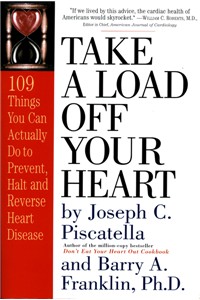|
|
Take A Load Off Your Heart
|

|
| Author: |
Piscatella J, Franklin B |
| Category: |
Health/Fitness |
| Audience: |
Consumer |
| Length: |
380 pages |
| Publisher: |
Workman Publishing Company |
| Year Published: |
2003 |
| List Price: |
$14.95 |
|
|
|
|
AthleteInMe.com®
Rating:



 Excellent!
Excellent!
Take A Load Off Your Heart is a review of the current thinking of factors that contribute to cardiovascular risk. • Recommended for: consumers who are at risk of heart disease.
ABOUT THE AUTHORS
• Joe Piscatella is the president of the Institute for Fitness and Health, in Gig Harbor, WA. Although not formally trained as a healthcare professional, Piscatella knows first-hand what cardiac disease can do: in 1977, at the age of 32, he had a heart attack and underwent open-heart surgery. He is the author of at least 5 other consumer health books (Don't Eat Your Heart Out, among others). He is the only nonmedical member of the NIH Cardiac Rehabilitation Expert Panel.
• Barry Franklin holds a PhD in physiology and is the director of the Cardiac Rehabilitation Program and Exercise Laboratory at William Beaumont Hospital, Royal Oak, MI. He is on faculty at Wayne State and the University of Michigan.
I have heard both men give presentations at ACSM and both are highly credible.
CONTENT
The book is divided into 4 sections:
- Assess Your Risk
- Manage Daily Stress
- Make Exercise a Habit
- Balance Your Diet
For some readers, simply following those 4 suggestions would be an improvement in their health. Take A Load Off Your Heart is written for consumers, however, the bibliography lists many citations from the primary medical literature, something not often seen in consumer-health books. The book is also very current: it captures some very recent scientific research regarding the physiology of cardiovascular events, such as fibrinogen levels, C-reactive protein levels, and homocysteine levels.
The authors propose a cardiovascular risk profile that includes the 3 factors listed above along with 7 others. I was happy to see "Aerobic Capacity" included on the list, as I believe the medical community still does not emphasize exercise often enough in patient encounters. The reader, however, will not be able to "rank" the importance of one factor versus another. For example, is being overweight worse than having a poor exercise capacity? While some scientific evidence suggests that being "fit but fat" reduces cardiovascular risk, readers may not be clear on this point. Nevertheless, the book offers many excellent suggestions to the reader regarding how they can improve their health. In fact, the subtitle of the book is "109 Things You Can Actually Do to Prevent, Halt and Reverse Heart Disease".
SUMMARY
In summary, this is an excellent book and, at only $14.95, I highly recommend it for people who have heart disease, or, more importantly, for those who wish to avoid it!
Copyright ©2005 AthleteInMe, LLC. All rights reserved.
| Reviewed by: Stan Reents, PharmD |
8/5/2015 9:17:43 AM |
|
|